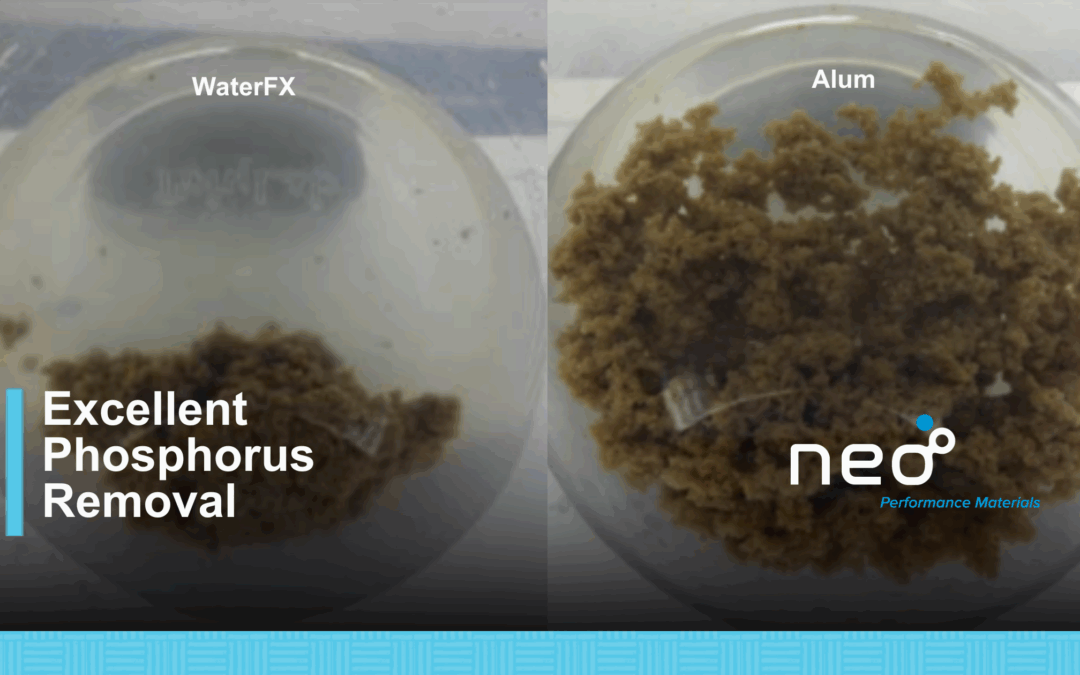When choosing a coagulant for removing phosphorus from wastewater, it may be tempting to select the “traditional” iron or aluminum coagulants. After all, these have been used in water treatment for decades and are “known”. However, when it comes to phosphorus removal, they have two very significant drawbacks:
- High doses, often 4 to 1 to as high as 10 to 1 coagulant to P on a molar basis, are required to remove phosphorus to the low levels required by many wastewater discharge permits. These high doses mean that these coagulants produce a LOT of chemical sludge.
- That fluffy chemical sludge binds water, making dewatering difficult. It is like trying to dewater Jello! That means even more chemicals, in the form of polymer must be added to assist in the dewatering process, and even that doesn’t yield a very dry final cake.
Neo Waterfx Requires A Much Smaller Dosage, Typically 1 To 1 On A Molar Basis To P.
The much lower dose produces much less chemical sludge, often 25 percent or less of the sludge produced using traditional coagulants. But just as significant, the sludge produced is a dense crystal that settles readily and actually facilitates dewatering. The result is less sludge and a much drier sludge cake, significantly reducing the sludge disposal costs.
A Pilot Study Helped Star Sewer Avoid A Costly Capital Project And Save Money On Chemicals And Sludge Disposal.
Star Sewer, near Boise, Idaho, was issued a seasonal phosphorus limit of 0.07 mg/L. They thought that meeting this low limit might require an expensive capital project to install tertiary filters. However, they decided to pilot test Neo WaterFX, as well as alum, both with and without the tertiary filters.
The results were stunning. First, they learned that while both WaterFX and alum could achieve the 0.07 mg/L limit without the tertiary filter, avoiding a major capital project, there was a significant difference in the operating expenses between the two coagulants. First, the dosage required to achieve this phosphorus reduction using WaterFX was less than a tenth of the dosage using alum (40 ppmv for WaterFX vs 430 ppmv for alum), resulting in chemical cost savings. In addition to the chemical cost savings, WaterFX would save significant money on sludge processing and disposal costs due to the reduction in chemical sludge and the ease and efficiency of dewatering vs alum.
Full-Scale Testing Showed Even Greater Efficiency And Savings
Full-scale testing revealed that over time, the dosage of WaterFX could be reduced even further, down to 22 ppmv, for even greater chemical and sludge processing savings. Over the 20-year life cycle costs, these savings will add up to millions in savings vs using alum.
Additional benefits were also identified that will make operations easier using WaterFX. To learn about those, read the case study for all the details at https://neowatertreatment.com/star-sewer-case-study-dosing-waterfx-300-in-mbr-system/?utm=abra-neowt.
Interested in seeing how WaterFX might save you money on phosphorus removal and sludge disposal? Call us for a free consultation.



